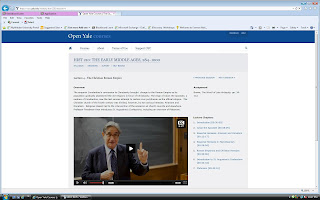Open
Yale Courses
History
Early Middle
Ages
I
never knew open courses existed for such reputable schools the likes
of Yale and Harvard. So instantly I gravitated to the Yale History
department. Since I teach the Middle Ages I naturally decided on
that subject. Going into the process, I was going back and forth on
what I was going to encounter. On the one hand, anything for free
will not be exactly as advertised. There has to be some sort of
catch for them to make money on this endeavor. On the other hand,
this is Yale not some scam company. What I received was a little of
column A and a little of column B. Yes, it is Yale and has some of
the greatest thinkers I will view lecturing. No, it isn't a scam;
but it also isn't the effort I expected out of Yale.
The
website looks very basic at first glance, and that is typically a
good thing. They incorporated multimedia and worksheets to gain
attention and further the lessons. However, the videos are 30-40
minute lectures. I remember from Dr. Simonson in Week 2's resources:
“The universities would try to videotape lectures and lessons to
place onto a DVD for reproduction in the distance learning process.
This was a failure because it was not equivalent to a classroom
setting. Having an identical setting is a fantasy.” (Laureate,
2013) So I was disappointed and feel robbed of the advertised Yale
Online learning experience.
Does the
course appear to be carefully pre-planned and designed for a distance
learning environment? How so?
It does not. It
appears to be a website for lectures and minimal additional
resources. Our text calls it shovelware, and it is when an
institution shovels the course online for the sake of saying they
offer online courses, but they do not think much about the process.
(Simonson, M., Smaldino, S., Albright, M., & Zvacek, S., 2012)
They do not allow for collaboration, quick feedback, or any type of
communication.
Does the
course follow the recommendations for online instruction as listed in
your course textbook?
There does not
seem to be any summative or formative assessments. It may only be 22
lectures with a reading list that makes Johnny 5 nervous.
There is an option to take a survey on the course, but that appears
to just be an informal evaluation of the course itself. The kiss of
death for distance learning courses is the lack of student
participation. (Simonson, M., Smaldino, S., Albright, M., &
Zvacek, S., 2012) This Yale course seems to have very little, if
any, student participation.
Did the
course designer implement course activities that maximize active
learning for the students?
Simply put; No.
The key to using quality instructional materials is that the
appropriate media is selected. (Simonson, M., Smaldino, S.,
Albright, M., & Zvacek, S., 2012) It seems the only activities
they list are pages in a workbook the learner has to purchase. An
example of a vague assignment they list is :
I
think the media isn't appropriate for online learning, but they did
not strive to place their best product into this open course. I
doubt there are many people looking forward to watching 11 hours of
lecturing and an additional 1,000 of reading and only complete
workbook assignments. Overall, this course might be a good addition
as a supplemental resource in my class once in a great while. As an
online course, this rates amongst the worst. In Yale's defense, they
cannot give their top dollar product's equivalent out for free. They
are a business and I am sure that their paid online courses are top
notch.
References
Laureate Education, Inc. (Producer).
(n.d.). Theory and Distance Learning [Video]. Retrieved from
http://laureate.ecollege.com Laureatte Education, (n.d.)
Simonson, M.,
Smaldino, S., Albright, M., & Zvacek, S. (2012). Teaching and
learning at a distance: Foundations of distance education (5th ed.)
Boston, MA: Pearson.

No comments:
Post a Comment